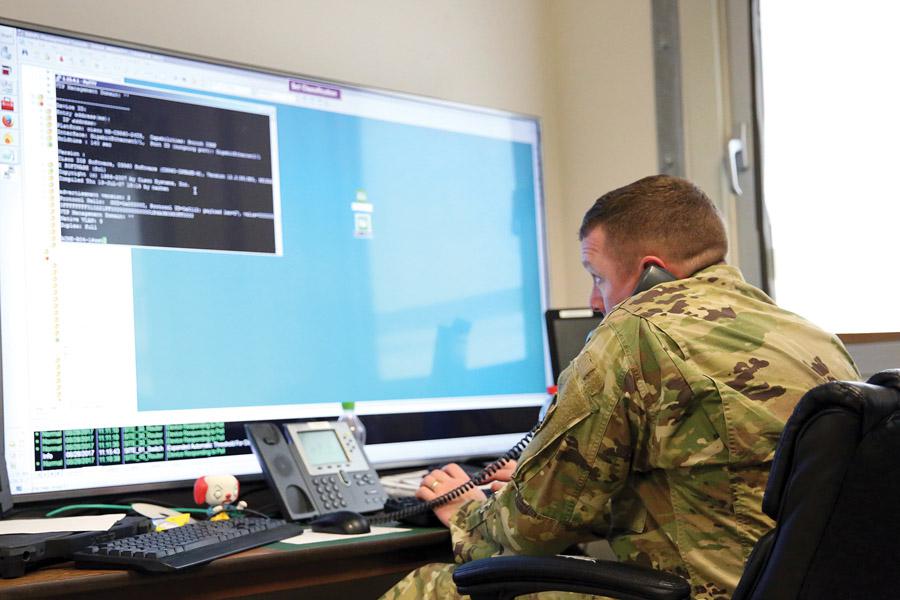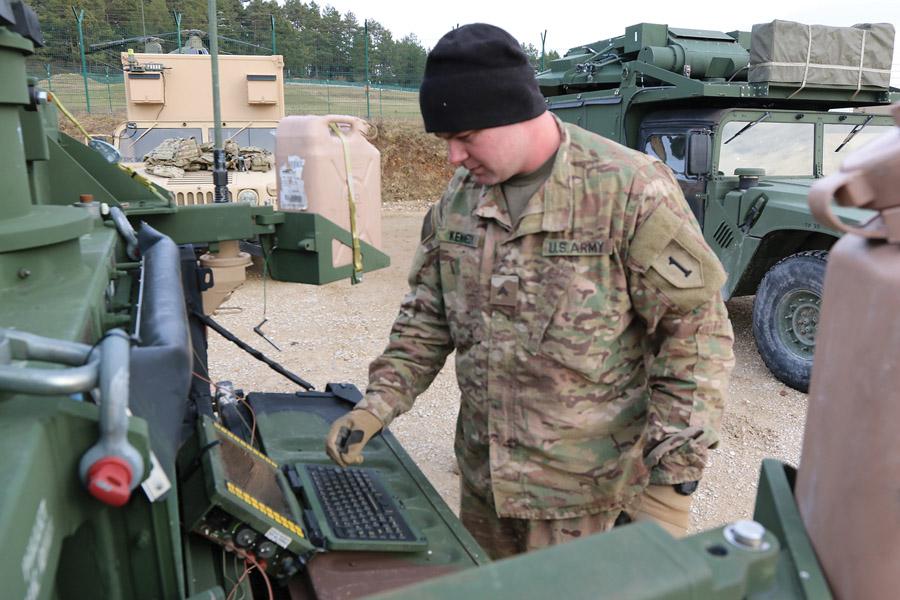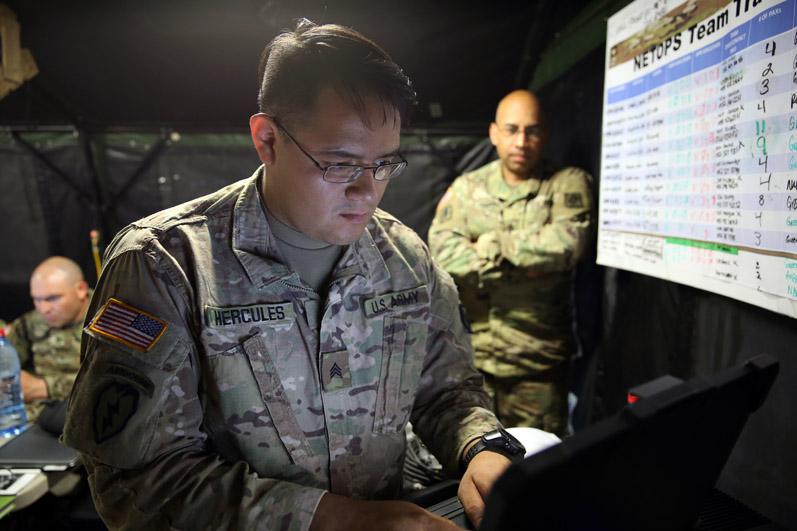Agile Integration Connects Continents
Future U.S. Army regionally aligned forces will benefit from experiences—and solutions—discovered during last year’s integration with the U.S. Army Europe communications network. Although their communicators expected to hit the ground running when they arrived in theater, integrating tactical communications systems was more difficult than expected. Fortunately, new technology and soldiers’ know-how not only solved the immediate problems but also set the stage for easier communications integration in the future.
The lessons began when the contiguous U.S. (CONUS) regionally aligned forces arrived at U.S. Army Europe (USAREUR), Grafenwoehr, Germany. The forces’ communicators quickly discovered integrating systems into a new USAREUR network domain required network and system administrators to complete revalidations of tactical systems before being allowed permissions.
In addition, brigade combat team commanders realized the amount of time tactical assemblages needed to become part of a new network domain jeopardized their communication capabilities. However, the Global Agile Integrated Transport (GAIT) considerably reduced this timetable, which enabled European theater commanders to address another potential risk: protected satellite communications. Integration of the Secure Mobile Anti-Jam Reliable Tactical Terminal (SMART-T) solved this issue for USAREUR units.
Project Manager Tactical Network (PM Tactical Network), formerly PM Warfighter Information Network–Tactical, tested GAIT in CONUS tactical environments. The transport connects the five geographically dispersed regional hub nodes and their 75 enclaves of baseband equipment into one seamless network capability for the tactical community using a scalable Type 1 encryption solution set. This global extension of the regional hub nodes’ colorless transport network uses multiprotocol label switching to provide end-to-end multitenancy.
Holistically, GAIT, developed with input from Envistacom, sews together the necessary components of the network to meet the commander’s intent. This new level of functionality resides within the tactical security demarcation, making it a true warfighter network that can deploy globally as the mission dictates.
GAIT’s solution set focused on the European area of operations and revolved around satellite communications. It enabled the transmission and networking components within a regional hub node to be decoupled, allowing for optimal placement of each node to best support Army operations using the “radio frequency anywhere” concept.
One of the first units to adopt GAIT into its deployed network plan was the 2nd Armored Brigade Combat Team, 1st Infantry Division (2/1 ABCT). To validate its baseband communications assets prior to deploying to Europe, the team worked closely with 302nd Signal Battalion regional hub node network engineers at Fort Bragg, North Carolina, to properly configure and tie in satellite communications resources with the 102nd Signal Battalion regional hub node network engineers in Landstuhl, Germany. The GAIT network operations center virtually connected the unit’s satellite communications equipment via psuedowire into the colorless baseband enclave required through GAIT.
Three days before the Dagger Focus 2/1 ABCT predeployment exercise, the Regional Satellite Communications Support Center–CONUS replanned 2/1 ABCT satellite communications resources to Camp Roberts’ regional hub node. Although challenging, this work allowed the PM Tactical Network team to show GAIT’s agility. Within 18 hours, the 2/1 ABCT satellite communications resources were terminated at Camp Roberts’ regional hub node and had a logical connection to the Landstuhl baseband architecture. As a result, the 2/1 ABCT tactical communications assets were properly exercised and existed virtually in Europe months before the brigade combat team’s arrival.
Because of GAIT’s capability, the integration into the European network domain was seamless to the commanders once on the ground. In addition, a process that normally took weeks was complete in a matter of hours.
Eager to improve the network integration process for regionally aligned forces, numerous stakeholders, including PM Tactical Network, USAREUR G-6, 2nd Theater Signal Brigade and 102nd Signal Battalion regional hub node engineers extended the capability GAIT provided to Europe, enabling a more efficient process for future theater integrations.
The 1st Air Cavalry Brigade was the second unit in Europe to integrate its communications assets into the network, leveraging the GAIT solution set executed mission command within a few hours after initial setup. As a result of this success, using GAIT in future regionally aligned forces deployments became the new standard.
The next units deploying into the European area, as well as units organized under the 2nd Theater Signal Brigade, have already started reaching out to utilize different operational solution sets GAIT offers. The GAIT network operations center, in conjunction with the 44th Expeditionary Signal Battalion and 102nd Signal Battalion regional hub node network engineers, executed high-speed redundant link and geographically separated task-organized operational solution sets. This provided the battalion connectivity from a specific theater to the regional hub node via a commercially leased communications circuit, resulting in a fault-tolerant redundant environment to the tactical satellite communications network.
The Geographically Separated Task Organized solution set enabled the 44th Expeditionary Signal Battalion to pull services from multiple regional hub nodes and maintain full mission command services within its respective areas of responsibility and further provide network operations from its geographically separated headquarters element.
With the 82nd Airborne Division, the GAIT network operations center is facilitating the execution of the first Distributed Mission Command solution set in Europe. It will enable commanders to extend their organic tactical—or base camp strategic—network to a theater of operations and could enable some equipment and personnel to remain at home base while allowing forward-deployed troops to access these resources.
This approach not only reduces setup time but also minimizes potential risk of loss or damage to servers during deployment. In addition, because less equipment is required in theater, the overall communications footprint is reduced, presenting fewer targeting opportunities for potential adversaries.
One of the latest capabilities tested and leveraged through GAIT is the integration of teleport satellite communications facilities. This move enabled the reintroduction of the SMART-T into the Army’s communication arsenal and, for the first time, directly into the European communications network. The platform expands the communications capabilities for deployed commanders in the European theater; however, the focus for protected waveforms again becomes a necessity in signal communications planning.
The Army uses the SMART-T communications asset to provide protected satellite communications for critical command and control links between commanders at brigade and higher echelons in an electronic warfare environment. Threats include radio frequency signal interference, anti-scintillation communications, signal detection and geographic location. In the past, SMART-T was employed to provide a protected beyond line-of-sight link for voice communications between commanders engaged in a theater operation. In this environment, SMART-T used extremely high frequency and provided up to a 1024 megabits per second (Mbps) data rate using medium data rate services.
Advances in the past five years have enabled the system to operate on advanced extremely high frequency connections, providing assured links up to 8192 Mbps using extended data rate services as well as the installation of Navy Multiband Terminals (NMT) at several Defense Information Systems Agency (DISA) Standard Tactical Entry Point/Teleport facilities. As a result, a SMART-T can connect to the agency’s services and receive unclassified and classified data services.
While these new capabilities permitted a SMART-T to provide voice and data command and control communications via a secure SATCOM link to maneuver commanders, integration into the Army command and control network enabled units to conduct mission command operations, which includes a seamless Primary, Alternate, Contingency, Emergency (PACE) element that provides significant benefits to the maneuver unit communications plan.
In January, PM Tactical Network led efforts with the 102nd Signal Battalion regional hub node engineers, DISA Europe Contingency Exercise Branch, Teleport Program Office and the U.S. Air Force 86th Communications Squadron to establish a GAIT point of presence at one of the teleport sites in Europe that holds the Navy Multiband Terminals capability. As a result, an Army PM Tactical Network baseband system Increment 1 or Increment 2 could use a SMART-T to access European strategic networks through the Landstuhl regional hub node, aligning the system as an integral part of any brigade commander’s PACE plan to conduct mission command.
In the following months, these teams coordinated and supported a validation exercise led by 2nd Theater Signal Brigade involving 44th Expeditionary Signal Battalion and USAREUR units, including the 2nd Armored Cavalry Regiment, 173rd Airborne Brigade Combat Team, 2/1 Brigade Combat Team regionally aligned forces and 1st Air Cavalry Brigade regionally aligned forces. This validation exercise was critical to further the development of SMART-T operations in Europe. It focused on planning and execution across the warfighter unit, regional hub node, GAIT network operations center, Regional SATCOM Satellite Communications–Europe, DISA Europe Contingency Exercise and teleport levels.
During the exercise, units configured SMART-Ts to terminate a secure link into the teleport that was then routed via GAIT to the regional hub node. This work established the colorless connection between the units’ Joint Network Node Tier 2 router and the regional hub node enclave router. During this process, 86th Communications Squadron Teleport technicians, 302nd Signal Battalion Camp Roberts Gateway technicians and Communications-Electronics Command logistics assistance representatives identified deficiencies in crypto strappings and created the standard for the KIV-7 configuration supporting SMART-T missions in Europe. The Joint Network Node, logistics assistance representatives, regional hub node and teleport technicians learned how to configure equipment to build a transport connection using GAIT to tap into a teleport facility. As a result, three Joint Network Nodes gained access to European strategic networks through the regional hub node utilizing SMART-T links into teleport. This new capability has enabled units to continue to plan and incorporate SMART-T into future exercises and operations.
Commanders are being advised to exercise the SMART-T as a backup link by simulating frequency-division multiple access and time-division multiple access failures. Adding these types of drills into the operations planning will ensure dexterity within the signal architecture and prepare signal soldiers to provide capable, protected satellite communications to the warfighting commander.
The signal community will need to rapidly close the knowledge gap on SMART-T planning and operation by leveraging the SMART-T operator and planner course as well as the Communications-Electronics Command logistics assistance representatives. Because the threat of operating in a degraded communications environment is continually increasing, SMART-Ts will become more relevant in Europe and return to being a crucial asset in any signal planner’s arsenal.
Chief Warrant Officer 2 Juan Muralles, USA, is the global operations officer in charge and network management technician in the U.S. Army Signal Activity–Kaiserslautern (USASA-K). Chief Warrant Officer 2 Wavell Williams Jr., USA, is the regional hub node officer in charge and network management technician in the USASA-K. Maj. Daniel Canchola, USA, is the 102nd Signal Battalion operations officer. Maj. Nicolas Beck, USA, is the 102nd Signal Battalion executive officer.










Comments